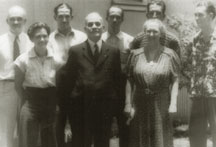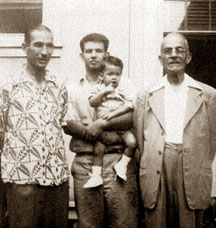Digital Collections
Celebrating the breadth and depth of Hawaiian knowledge. Amplifying Pacific voices of resiliency and hope. Recording the wisdom of past and present to help shape our future.
Kīhei de Silva (great-grandson of Ernesto Gomes da Silva)
Name: The Reverend Ernest Gomes da Silva
Place of Birth: San Antonio Parish, Funchal, Ilha da Madeira, Portugal
Date of Birth: October 29, 1873
Date of Death: March 2, 1955
Place of Death: Hilo, Hawaiʻi
Spouse: Louisa Dias. b. December 12, 1881 in Honolulu. d. August 14, 1942, in Hilo.
Married: June 1, 1899, at the Portuguese Evangelical Church of Honolulu
Places of Residence: Honolulu, Pāʻia (Maui), Hilo
Parents: Antonio Gomes da Silva, Carlota Augusta Rodrigues
Children, grandchildren:
Surnames: de Silva, Alverson, Bramstedt, Canario, Peterson, Bright, Tam Hoy, Smith, Kamakaʻala
Ernesto Gomes da Silva arrived in Honolulu on April 12, 1888, aboard the English sailing vessel Thomas Bell after a 156-day journey around the Horn. He traveled with his parents and sister Carmen; they were met by three of his brothers who had already established a family home on Miller St. Ernest learned English at Queen Emma Hall and put aside his early training as a cabinetmaker to became a jeweler’s apprentice at Wichman Co., a trade that he pursued until 1895 when he opened a grocery business with August G. Serrao. A year later, he began to study for the ministry at the North Pacific Missionary Institute of Honolulu.
Raised as a Roman Catholic, Ernest had turned Protestant in 1892 when Central Union Church established its Portuguese mission in Punchbowl. According to family member Mary Frias, the contentious da Silva boys all headed to the mission looking for an argument: “Ernest in particular was ready for a fight, but to their amazement, he was converted to the religion. Tony [his oldest brother] was so mad . . . that he asked him to move out of the house and [said] that he didn’t want to ever speak to him again.”
Ernest da Silva was ordained by the Portuguese Evangelical Church on June 11, 1899, after working for the Hawaiian Evangelical Board in Maui where he sold Bibles and distributed religious tracts, mostly from donkey-back, on the Hāna to Lahaina circuit. A month after his ordination, he was sent to Hilo to replace R. K. Baptist as pastor of the Portuguese Christian Church (later renamed Central Christian Church), a post that ended five months later with Baptist’s return. Da Silva spent the next two years in Maui where he opened a church at Portuguese Camp above Pāʻia Mill and ministered to other plantation camps at Huelo, Hāmākuapoko, and Puʻunēnē.
He was recalled to Hilo’s Portuguese Church in 1902. In time, he built a branch chapel in Kaiwiki and expanded his ministry to the labor camps of ʻŌlaʻa, ʻAmauulu, and Honomū. The Rev. Richard Wong, da Silva’s successor at Central Christian, remembers that da Silva was unique in two respects: he went to all the labor camps regardless of nationality, and he often preached in the language of his audience. The Hawaiians loved him for this, as did the Filipinos, Puerto Ricans, Chinese, and Japanese.
Ernest da Silva tried to retire in 1939, but his congregation would not allow it. His grandson Edwin de Silva Jr., who was raised on the third floor of the Haili St. parsonage, remembers that even as an older man da Silva held to a busy schedule. A typical Sunday began with an early-morning service at Kaiwiki, followed by Sunday school on the first floor of the parsonage, followed by 11 a.m. and 6 p.m. services next door at Central Christian. He continued to serve his church until his death in 1955; his 53-year tenure is one of the longest of any minister in Hawaiʻi.
Ernest married Luisa Dias on June 21, 1899. Her 1898 Honolulu Directory listing as a teacher at the Portuguese Kindergarten on Miller St. identifies her as one of Hawaiʻi’s first teachers of Portuguese descent. Edwin Jr. remembers that ministers’ wives of those days weren’t supposed to work, but Luisa, like her husband, did not bend readily to convention. In Hilo, she took employment as a clerk and seamstress at E. N. Holmes. Later, she opened the Vogue Shop, a clothing store that she and her daughter-in-law Hazel de Silva ran for many years.
Ernest and Louisa had ten children; eight survived to adulthood. Of these, six became educators, one a politician-businessman, and one a mechanic who could “fix anything that ran.” The da Silva family, re-situated in the 1940s to a multi-dwelling tract on the outskirts of Hilo, continued to revolve around its avô, its grandfather: da Silva required everyone’s presence at church, family dinners, and all holiday celebrations. Skill at self-expression was ever the sine qua non of his household; his children and grandchildren engaged in constant discourse: singing, laughing, arguing, analyzing, and teasing, often at the tops of their lungs, often at the cost of injured feelings, and always as part of the impassioned process of forging—for all its quirks and contradictions—an unmistakable “de Silva” identity.
Although he was my bisavô, my great-grandfather, I was raised to call him “Avu,” a variation of avô. Avu lived on Kīlauea Avenue, across the street and a little bit Hilo-side of our place, in the main house of the Portuguese “kauhale” whose matriarchs, by then, were his daughter Lu and the irrepressible Mary Frias. Avu died when I was five; my memories, therefore, are of a frail, dignified man seated on a doily-armed, stuffed chair in the living room of a house surrounded by brilliant, contentious, impassioned de Silvas. My memories are faint, but his legacy is still powerful. Today—even for my children, nieces, and nephews—the admonition “you’re a de Silva” carries spine-stiffening impact and irrevocable meaning.

photo credit: Kīhei de Silva
Ernest and Louisa da Silva with children: Ernest Jr., Lucille, Edwin, Charles, Lionel ("Leo"), and Clement ("Cobby").

photo credit: Kīhei de Silva
Four de Silva generations: Edwin de Silva Sr., Edwin ("Spud") de Silva Jr., Kīhei de Silva, and Ernest Gomes da Silva.